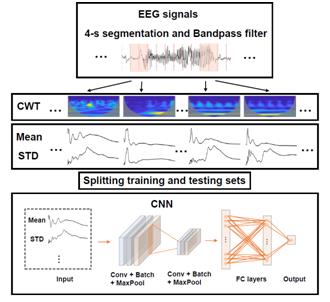Around 1% of the world population suffer from the epilepsy, one third of which are drug-resistant, requiring the physical intervention. EEG signals of absence seizure are similar to those of other brain disorders with similar symptoms, such as inattentive attention-deficit hyperactivity. Clinically, manually scanning EEG signals to identify seizure activities is time-consuming, error prone with low consistency among physicians. Thus, it is crucial to develop accurate and reliable automatic seizure detection algorithms for informing care-givers to help the patients.
Joint spectral-temporal features are believed to contain sufficient and powerful information about seizure activities, but too complicated with redundant information, leading to large computation and not suitable for application in the existing neurostimulation device, e.g., the commonly used in clinics: Responsive Neurostimulation System (RNS). Thus, finding significant spectral-temporal features for seizure detection remains an open problem
Recently, a research group led by Prof. YANG Dongping from Fujian Institute of Research on the Structure of Matter of the Chinese Academy of Sciences reported a reliable, effective and stable automatic generalized seizure detection system based on EEG signals, paving the way for technologies of online seizure onset detection as well as further intervention based on EEG signals.
The study was published in IEEE Transactions on Neural Systems and Rehabilitation Engineering .
The achievement of such a novel absence seizure detection framework utilizes significant low-dimensional spectral-temporal features in terms of mean-standard deviation of wavelet transform coefficient (MS-WTC). MS-WTC method takes the statistical information of time-frequency image at each scale, preserving the ability to capture the intrinsic properties of non-stationary signals and effectively reducing the feature dimension by removing the redundant information involved in the 2D time-frequency image produced by continuous wavelet (CWT). The method is motivated by the significant discovery in neuroscience that the first and second order moments of neuronal spiking signals dominate more than 90% information of the real retinal activities. Thus, the mean and variance (standard deviation in our study), as the most significant features, are expected to take sufficient information of the original signals for further processing.
The researchers evaluated the reliability, effectiveness and stability of the proposed method in seizure detection, by comparison with other methods using low-dimensional temporal and spectral features, such as EMD and FFT. The performance results demonstrated that the MS-WTC method is accurate in seizure detection on the published database A, Bonn database, as well as the clinical database B collected from the Chinese 301 Hospital. These validate that the proposed low-dimensional spectral-temporal features are significant for generalized seizure detection.
The study extracts the significant and compact statistical information inside the time-frequency image, which has been shown to be sufficient and powerful feature information for seizure detection as well as prediction.

Flowchart of the proposed seizure detection framework (Image by Dr. YANG’s group)
Contact:
Prof. YANG Dongping
Fujian Institute of Research on the Structure of Matter
Chinese Academy of Sciences
Email: dpyang@fjirsm.ac.cn